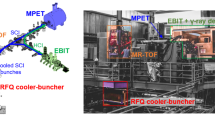Abstract
The Time-of-Flight (ToF) technique can be used for mass identification, for separation of a specified mass or for measuring the energy of a given mass particle. The instrumentation required is simple and low in cost. The method features high yield, transmission efficiency is typically of 5 to 20%. Even with short flight paths (5 to 10 cm), ToF has adequate mass resolution (M/ΔM∼300 to 500) for identifying isotopic species. This paper examines the scope of ToF in nuclear science with examples in mass spectrometry, in mass separation and in kinetic energy measurements of fixed mass particles. An example of the latter is the energy determination of recoil nuclei. If a recoil is produced inside a solid, the residual recoil energy reveals the depth from which it originates. This approach is used for profiling nitrogen via14N(n, p)14C. The ToF measurement of the14C recoil energies reveals the depth distribution of nitrogen with better than 50 Å resolution.
Similar content being viewed by others
References
A. L. Burlingame, R. K. Boyd, S. K. Gaskell, Anal. Chem., 66 (1994) 684R.
M. C. Michel, UCRL 2267, 1953.
S. Thulin, Arkiv Fys., 4 (1952) 363.
J. Von Pulker, E. Ritter, Vakuum Technik, 14 (1965) 91.
I. Bergstron, K. Bjorkquist, B. Domeij, G. Fladda, S. Anderson, Can. J. Phys., 46 (1968) 2679.
D. J. Keith, Ph.D. Dissertation, Texas A & M University, 1983.
C. F. Feldman, J. W. Mayer, Fundamentals of Surface and Thin Film Analysis, Elsevier Science Publishing Co., Amsterdam, 1986.
R. A. Weller, Nucl. Instr. Meth. Phys. Res., B47 (1993) 193.
A. Chevarier, N. Chevarier, S. Chiodelli, Nucl. Instr. Meth., 189 (1981) 525.
M. Döbeli, P. C. Haubert, R. P. Livi, S. J. Spicklemire, D. L. Weathers, T. A. Tombrello, Nucl. Instr. Meth. Phys. Res., B47 (1990) 148.
R. T. Sullins, C. V. Barros Leite, E. A. Schweikert, J. Radioanal. Chem., 78 (1983) 171.
J. F. Zeigler, G. W. Cole, J. E. Baglin, J. Appl. Phys., 43 (1972) 3809.
R. G. Downing, R. F. Fleming, J. K. Langland, D. H. Vincent, Nucl. Instr. Meth., 218 (1983) 47.
G. P. Lamaze, R. G. Downing, J. K. Langland, S. T. Hwang, J. Radioanal. Nucl. Chem., 160 (1992) 315.
J. T. Maki, R. F. Fleming, D. H. Vincent, Nucl. Instr. Meth., B17 (1986) 147.
Author information
Authors and Affiliations
Rights and permissions
About this article
Cite this article
Schweikert, E.A., Welsh, J.F. An old-new tool for nuclear analysis: Time-of-Flight spectrometry. J Radioanal Nucl Chem 215, 23–30 (1997). https://doi.org/10.1007/BF02109873
Received:
Issue Date:
DOI: https://doi.org/10.1007/BF02109873



